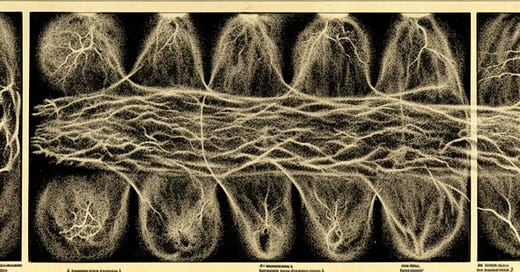In the Somatic Energy Regime
A first note of context/endnote for a forthcoming history of nitrogen
Dear reader, my intention with this substack is to produce in public a coherent book on petrohistory, but what you’re getting here is far from the fully realized work. To support this project, buy a paid subscription now, and I’ll send you a “free” copy of the book in a few years, when it’s ready. It will be better than the below.
(1)
In this context, the environment is a machine which converts solar energy into biochemical energy; the nature of that conversion from light to plant and then plant from animal and then animal to money defined life in the somatic energy regime, when all energy was of a body. At the time, another energy regime would not have been imaginable. What else could there be? Exosomatic energy, it turned out: energy that came from outside of bodies. First it was coal, and soon enough oil and methane–-people call it “fossil fuels,” where “fossil” means only “something which has been dug up.” Still solar energy, but fully digested by the earth. There are today other types of exosomatic energy, including hydropower, wind, etc.; what matters is that labor was not the only physical power anymore. That is why I tend to call it the exosomatic energy regime, rather than the fossil fuel regime.
In the somatic regime, energy was converted from calories to wealth via animal (human and nonhuman) labor. The population determined the amount of energy that could be put into the human endeavor of creating value to be hoarded by the species’ worst specimens. It was certainly possible to live on the earth free of that greed; many people did. But the Europeans decided that they did deserve to be rich, and so they developed a technology of immense cruelty: colonialism is functionally synonymous with slavery.
In this way, the somatic energy regime came to be defined entirely by racism. Racism, as a technology of thought, was indispensable to the direct administration of any cruel and exploitative empire, and they got crueler as the process progressed. Only open white supremacy could justify the crimes committed by the English. The great lie of white supremacy was essential to the shape of the world on the eve of the industrial revolution.
Colonialism and capitalism both grew as a technology of exploitation that stole many things, but especially cheap labor. Demand for cheap labor drove an increase in the world population, as well as an increase in the amount of land being converted into grain fields. 20 million hectares of land was converted into agricultural productivity between 1850-1900. Land became more valuable even as they stole it from people. Colonialism, driven as it was by enterprise, imposed a growth imperative on the world, and the limit to that growth was the quantity of calories that could be coaxed out of a single acre of arable land.
And it was in the midst of that regime that industrialization was incubated by coal fire. This is an unacknowledged reason why the Chimney Sweep was such a resonant image of the time: it was blackface, the fear of a white child getting turned Black by coal soot was pleasurably titillating to the very twisted late Victorian mind.



